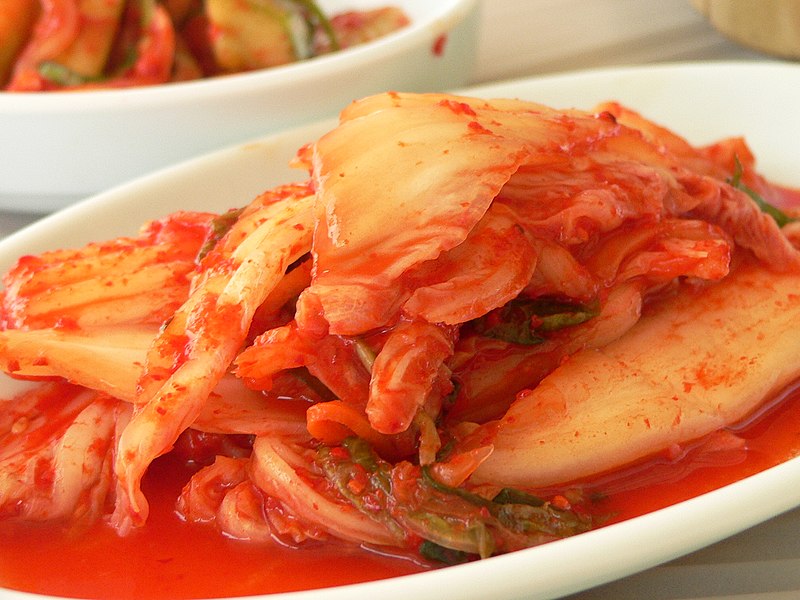The key difference between kimchi and sauerkraut is that kimchi contains vegetables, seasoning, and seafood, whereas sauerkraut contains only cabbage and salt. Both kimchi and sauerkraut are fermented dishes made using vegetables and lactic acid bacteria. They are gluten-free, nutritious, inexpensive, rich in probiotics, and can be made at home. They can be eaten alone, used as a side dish, or combined with main dishes. They also have an Asian origin.
Key Takeaways
- Kimchi is a traditional Korean dish made with various vegetables, seasoning, and seafood, while sauerkraut is a fermented cabbage dish originating from China.
- Both kimchi and sauerkraut are rich in probiotics and nutrients, promoting health benefits such as supporting the immune system, heart health, and aiding weight loss.
- Kimchi typically takes a few weeks to ferment, whereas sauerkraut takes about 20 days, resulting in different flavors and textures.
What is Kimchi?
Kimchi is a traditional Korean dish. This is a staple in Korea and includes vegetables, chili, garlic, ginger, pepper, salt, spring onion, salted seafood, and fish salt. The fermented vegetables are usually cabbage or radish, but we can use cucumber, celery, spinach, and scallions. Kimchi is fermented in large earthenware jars stored in partially underground cellars or sheds built for this purpose. This takes for around a few weeks, yet it depends on the weather.
At first, kimchi was a way to preserve food in winter, but now there are numerous Kimchi recipes available based on the vegetables you use, the season, and the region in which they are made. If you keep all the ingredients plant-based, you can easily make it a vegan dish.
Kimchi is not expensive and available commercially. It can be easily made at home, yet it takes time since it mainly involves fermenting or pickling. During this time, its flavors and nutritional value develops. Kimchi can be kept in the fridge for several months and can be served with almost any meal. However, with time, the vegetables may lose their crispiness, and the flavors will become more pungent.
Kimchi can be eaten by itself, as a side dish, or as an appetizer. It is also used as an ingredient in different dishes like Kimchi Jjigae (a traditional stew) to flavor fried rice, noodles, sandwiches, stir-fry dishes, and in pizza. Kimchi is mainly sour and spicy. But these flavors will change based on the vegetables, fermentation period and the amount of salt, sugar, and pepper added to them.
There are various benefits to kimchi: they are it is rich in many nutrients, contains probiotics, strengthens the immune system, supports heart health, slows down the aging process, reduces inflammation, prevents yeast infections, and aids weight loss. But, there are disadvantages to kimchi as well, including food poisoning linked to E. Coli and norovirus outbreaks. To avoid these, it is important to buy kimchi from safe places and to store them correctly.
What is Sauerkraut?
Sauerkraut is a type of dish made using fermented cabbage. It is a famous dish in Germany yet originated in China around 2000 years ago. Most of the time, sauerkraut uses green or red cabbage, but some recipes also include other ingredients like carrots, apples, and caraway seeds.
Sauerkraut is made using finely chopped cabbage. It is fermented using lactic acid bacteria for about 20 days, and this takes an acidic, tangy, and sour taste. Then it is combined with salt and put into a container to get fermented. With the help of this salt solution, the favorable bacteria on the surface of the cabbage convert sugar into lactic acid. Then gradually, it becomes sour and crunchy.
Sauerkraut has a lot of vitamin C and K, and it also has a long shelf-life. Therefore, sailors often eat sauerkraut topped with sea salt to get rid of scurvy. It is inexpensive and can be made at home. But, be careful not to buy pasteurized, sugary, and preserved varieties.
This fermented dish has many nutrients and helps digestion. It boosts the immune system, helps you to lose weight, helps to reduce stress and maintain brain health, promotes heart health and reduces the risk of breast cancers, and helps in stronger bones.
What is the Difference Between Kimchi and Sauerkraut?
The key difference between kimchi and sauerkraut is that kimchi includes vegetables, seasoning, and seafood, while sauerkraut has only cabbage and salt. Moreover, kimchi takes about a few weeks to get fermented, and sauerkraut takes about only a few days. Since kimchi includes more ingredients, it is healthier than sauerkraut.
Summary – Kimchi vs Sauerkraut
Kimchi is a traditional Korean dish that contains ingredients like vegetables, seasoning, and seafood; therefore, it is healthier than sauerkraut, which includes only cabbage and salt. Moreover, kimchi has a salty taste, unlike sauerkraut which is tangy and acidic and takes more time for fermentation. Thus, this is the summary of the difference between kimchi and sauerkraut.
